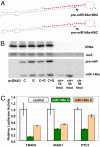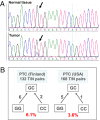Common SNP in pre-miR-146a decreases mature miR expression and predisposes to papillary thyroid carcinoma
- PMID: 18474871
- PMCID: PMC2438239
- DOI: 10.1073/pnas.0802682105
Common SNP in pre-miR-146a decreases mature miR expression and predisposes to papillary thyroid carcinoma
Abstract
Although papillary thyroid carcinoma (PTC) displays strong heritability, no predisposing germ-line mutations have been found. We show that a common G/C polymorphism (rs2910164) within the pre-miR-146a sequence reduced the amount of pre- and mature miR-146a from the C allele 1.9- and 1.8-fold, respectively, compared with the G allele. This is matched by a similar decrease in the amount of each pre-miR generated from the corresponding pri-miR-146a in an in vitro processing reaction. The C allele also interfered with the binding of a nuclear factor to pre-miR-146a. The reduction in miR-146a led to less efficient inhibition of target genes involved in the Toll-like receptor and cytokine signaling pathway (TRAF6, IRAK1), and PTC1 (also known as CCDC6 or H4), a gene frequently rearranged with RET proto-oncogene in PTC. In an association study of 608 PTC patients and 901 controls, we found marked differences in genotype distribution of rs2910164 (P = 0.000002), the GC heterozygous state being associated with an increased risk of acquiring PTC (odds ratio = 1.62, P = 0.000007), and both homozygous states protective with odds ratio = 0.42 for the CC genotype (P = 0.003) and odds ratio = 0.69 for the GG genotype (P = 0.0006). Moreover, 4.7% of tumors had undergone somatic mutations of the SNP sequence. Thus, our data suggest that a common polymorphism in pre-miR-146a affects the miR expression, contributes to the genetic predisposition to PTC, and plays a role in the tumorigenesis through somatic mutation. Preliminary evidence suggests that these effects are mediated through target genes whose expression is affected by the SNP status.
Conflict of interest statement
The authors declare no conflict of interest.
Figures



References
-
- Jemal A, et al. Cancer statistics 2007. CA Cancer J Clin. 2007;57:43–66. - PubMed
-
- Grieco M, et al. PTC is a novel rearranged form of the ret proto-oncogene and is frequently detected in vivo in human thyroid papillary carcinomas. Cell. 1990;60:557–563. - PubMed
-
- Bongarzone I, et al. Frequent activation of ret protooncogene by fusion with a new activating gene in papillary thyroid carcinomas. Cancer Res. 1994;54:2979–2985. - PubMed
-
- Cohen Y, et al. BRAF mutation in papillary thyroid carcinoma. J Natl Cancer Inst. 2003;95:625–627. - PubMed
-
- Fukushima T, et al. BRAF mutations in papillary carcinomas of the thyroid. Oncogene. 2003;22:6455–6457. - PubMed
Publication types
MeSH terms
Substances
Grants and funding
LinkOut - more resources
Full Text Sources
Other Literature Sources
Medical
Miscellaneous

